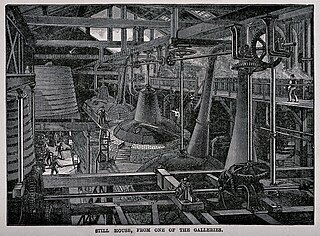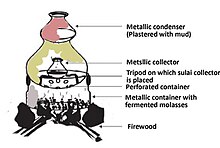
Whisky or whiskey is a type of liquor made from fermented grain mash. Various grains are used for different varieties, including barley, corn, rye, and wheat. Whisky is typically aged in wooden casks, which are typically made of charred white oak. Uncharred white oak casks previously used for the aging of port, rum or sherry are also sometimes used.

Thai Beverage, better known as ThaiBev (Thai: ไทยเบฟ), is Thailand's largest and one of Southeast Asia's largest beverage companies, with distilleries in Thailand, UK, and China. It is owned by Thai Chinese billionaire business magnate Charoen Sirivadhanabhakdi. Listed on the Singapore Stock Exchange, Thai Beverage plc has a market capitalization in excess of US$13 billion.

Arak or araq is a distilled Levantine spirit of the anise drinks family. It is translucent and unsweetened.

Feni is a spiritous liquor type originating in Goa, India. The two most popular types of feni are cashew feni and coconut feni. Depending on the ingredients; however, other varieties and newer blends are also sold by distilleries. The small-batch distillation of feni has a fundamental effect on its final character, which still retains some of the delicate aromatics, congeners, and flavour elements of the juice from which it is produced.

Baijiu, or shaojiu, is a colorless Chinese liquor typically coming in between 35% and 60% alcohol by volume (ABV). Each type of baijiu uses its own type of qū for fermentation to create a distinct and characteristic flavor profile.

Liquor or distilled beverages are alcoholic drinks produced by the distillation of grains, fruits, vegetables, or sugar that have already gone through alcoholic fermentation. Other terms for liquor include spirit, spirituous liquor or hard liquor. While the word liquor ordinarily refers to distilled alcoholic spirits rather than beverages produced by fermentation alone, it can sometimes be used more broadly to refer to any alcoholic beverage.

Pálinka is a traditional fruit spirit with origins in the medieval Hungary, known under several names. Protected as a geographical indication of the European Union, only fruit spirits mashed, distilled, matured and bottled in Hungary and similar apricot spirits from four provinces of Austria can be called "pálinka", while "Tótpálinka" refers to wheat-derived beverages. Törkölypálinka, a different product in the legal sense, is a similarly protected pomace spirit that is commonly included with pálinka. While pálinka may be made of any locally grown fruit, the most common ones are plums, apricots, apples, pears, and cherries.

Arrack is a distilled alcoholic drink typically produced in Sri Lanka and Southeast Asia, made from the fermented sap of coconut flowers or sugarcane, and also with grain or fruit depending upon the country of origin. It is sometimes spelled arak, or simply referred to as 'rack or 'rak. It is not to be confused with the anise-flavored distilled spirit called arak or araq. In many parts of India arrack is colloquially known as "desi daru".
Purposeful production of alcoholic drinks is common and often reflects cultural and religious peculiarities as much as geographical and sociological conditions.

Erguotou is a style of qingxiangbaijiu originating in Beijing and primarily made in the region surrounding.

As of 2006 most distilled spirits labelled as "whisky" in India were a form of Indian-made foreign liquor, commonly blends based on neutral spirits that are distilled from fermented molasses with only a small portion consisting of traditional malt whisky, usually about 10 to 12 percent. Outside India, such a drink would more likely be labelled a rum. According to the Scotch Whisky Association's 2013 annual report, unlike in the European Union (EU), "there is no compulsory definition of whisky in India, and the Indian voluntary standard does not require whisky to be distilled from cereals or to be matured. Very little Indian 'whisky' qualifies as whisky in the EU owing to the use of molasses or neutral alcohol, limited maturation and the use of flavourings. Such spirits are, of course, considerably cheaper to produce than genuine whisky." Such molasses-based blends made up 90 percent of the spirits consumed as "whisky" in India in 2004, although whisky wholly distilled from malt and other grains, was also manufactured and sold. By 2004 shortages of wheat had been overcome and India was one of the largest producers. Amrut, the first single malt whisky produced in India, was launched in Glasgow, Scotland in 2004. After expanding in Europe it was launched in India in 2010.
Indian-made foreign liquor (IMFL) is the official term used by governments, businesses and media in India to refer to all types of liquor manufactured in the country other than indigenous alcoholic beverages such as feni, toddy, arrack and others.

Rum is a liquor made by fermenting and then distilling sugarcane molasses or sugarcane juice. The distillate, a clear liquid, is often aged in barrels of oak. Rum originated in the Caribbean in the 17th century, but today it is produced in nearly every major sugar-producing region of the world, such as the Philippines, where Tanduay Distillers, the largest producer of rum worldwide, has its headquarters.

An alcoholic beverage is a beverage containing alcohol (ethanol). Alcoholic drinks are typically divided into three classes—beers, wines, and spirits—and typically their alcohol content is between 3% and 50%.

Desi daru, also known as country liquor or Indian-made Indian liquor (IMIL), is a category of liquor made in the countryside of the Indian subcontinent. It is traditionally prepared by a procedure that has been passed down for centuries. Due to cheap prices, country liquor is the most popular alcoholic beverage among the impoverished people. It is fermented and distilled from molasses, a by-product of sugarcane. Desi liquor is a broad term and it can include both legally and illegally made local alcohol. The term desi daru usually refers to legal alcohol while other types of country liquor may be categorised as moonshine alcohol.
Intoxicants in Sri Lanka are legal in certain contexts. One can legally buy most alcohols, tobaccos, and certain herbals through licensed ayurvedic shops, who are provided the raw materials by the Ministry of Health and then compelled to produce solutions/products that are then sold to the public. It is also possible to purchase tobacco from convenience stores and alcohol from several licensed stores.
Alcohol It is legal to produce upto 60 Litres of fermented beverage and distill 30 litres Raksi per year for personal consumption, but it's illegal to sell home-made Raksi spirit in Nepal. The mixed society coupled with caste and multiple ethnic results in an extremely complex social structure which also generally affects alcohol consumption among the people based on their background. There are mainly two types of people in Nepal depending on alcohol use. The group of people who do not drink or use alcohol are called Tagadhari (तगाधारी), and the other group who drink alcohol are called Matawali. Traditionally, the Brahmins and Kshatriyas are the Janai wearers and are forbidden from consuming alcohol, with the exception of Matwali Chhetris of Karnali region who are permitted to use alcohol. Alcohol also plays an important role in rituals, festivals and religious ceremonies. Matwalis largely use alcohol for their traditional purposes and generally brew alcohol by themselves. Peoples such as the Tharu, Kirati people, Magar, Gurung, Tamang, and Newars preserve these practices.

The following outline is provided as an overview of and topical guide to whisky:














